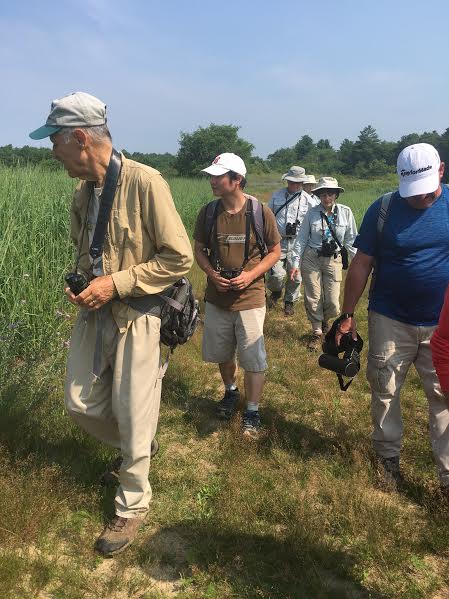
For many people, the colorful creatures that flutter by them go unnoticed as they become enmeshed in their busy schedules.
But butterflies are worth stopping for and seeking out to members of the Massachusetts Butterfly Club, a chapter of the North American Butterfly Association.
Club members braved the heat July 16 to visit Noquochoke Wildlife Management Area on Hixville Road in search of butterflies.
Searching for these winged insects, club member Blake Dinius said, has a certain Zen quality.
“They really force you to slow down,’’ he said. “You’re not going to see them if you’re racing down the trail. ‘’
The search for butterflies helped him slow his pace, he said, because “it’s almost like a meditative process.’’
The butterflies move quickly and purposefully, he said, so you don’t always have great amounts of time to observe them.
“I enjoy it while it’s there,’’ he said. “You have to be OK with that.’’
“They’re just really attractive insects,’’ said Joe Dwelly, a veteran butterfly watcher. “They’re also good indicators of the ecosystem.’’
A healthy variety of butterflies generally reflects a healthy variety of plants in an area, he said.
Butterflies can often be found in open fields or meadows, in search of plants that provide nectar, which helps fuel their flight.
But club member Andrew Griffith, who is the operations director for Dartmouth Week, also had his eyes peeled on an unlikely spot: A puddle in the dusty dirt parking lot.
It turns out that butterflies really appreciate the mud in puddles.
The minerals in the mud are very beneficial to them, Griffith said.
He has heard that as many as 20 butterflies can sometimes be seen “puddling,’’ although the parking lot puddle went unvisited.
Wendy Miller was a bird-watching enthusiast when she learned about butterfly watching and became enthralled with the winged insects. “You can see them more easily,’’ she said. “Butterflies are at eye level — you can study them.’’
Walks are one way to attract butterflies, but they can also be seen in backyards, Griffith said.
To draw butterflies to a yard, consider nectar sources, Griffith said. “Milkweed is a great one to attract butterflies,’’ he said.
Other native flowers, including New England asters, and bushes such as sweet pepperbush are great sources of nectar, even late into the butterfly season, Griffith noted.
While dawn and dusk can be busy times for birds, butterflies are more active from 9 a.m. to 3 p.m. and enjoy the sunshine, he said.
Butterflies look for a nectar source and host plants to lay their eggs, which will then turn into caterpillars.
Those caterpillars then complete the cycle by transitioning into butterflies.
During their Friday morning walk, the group found approximately 70 individual butterflies, with species such as monarchs, sulphurs, duskywings, hairstreaks and wood nymphs.
Griffith enjoys photographing butterflies, particularly smaller varieties that may be less recognizable to people. Larger butterflies such as monarchs and swallowtails, may be more familiar to people, he said, but he likes to photograph smaller versions and “bring them to people’s attention.’’
“I like people to see all the different species that are out there,’’ he said.
.For more information on the Massachusetts Butterfly Club, visit https://www.naba.org/chapters/nabambc/index.asp.
"gather" - Google News
July 20, 2021 at 03:47AM
https://ift.tt/2UYjI5i
Zen and the art of butterfly watching: Enthusiasts gather to explore - Dartmouth Week
"gather" - Google News
https://ift.tt/2Sqdbwp
https://ift.tt/2Yjhqxs
Bagikan Berita Ini














0 Response to "Zen and the art of butterfly watching: Enthusiasts gather to explore - Dartmouth Week"
Post a Comment